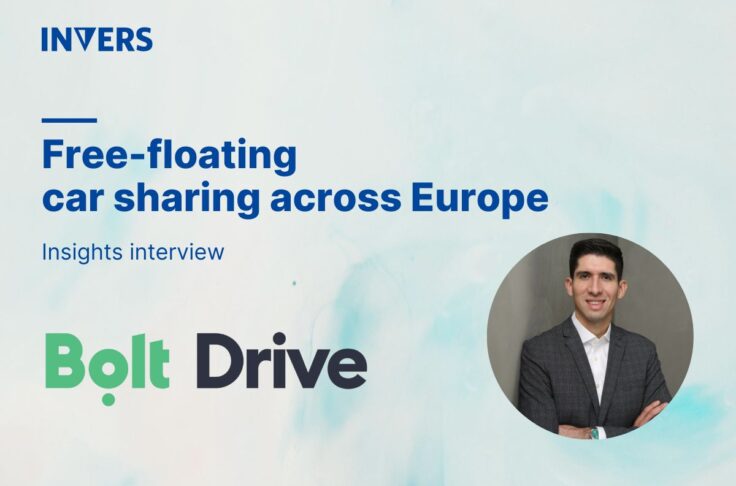Top 5 Use Cases for a Driving Score in Car Sharing

Summary
A driving score compiles telematics data into a predefined rating system to provide an objective view of customers’ driving behavior. Car sharing operators use it to identify bad drivers, educate customers, or reward responsible driving. It helps optimize insurance and maintenance costs by reducing the risk of damage or accidents.
Introduction
As a car sharing operator, you receive hundreds of customer reviews. People comment on your service, pricing, as well as vehicle availability and condition.
That’s fine and part of the business. But what about your customers? Most of them might be excellent drivers, but some just don’t follow the rules because they don’t fear any consequences. How can you rate their driving behavior?
The latest car sharing technology usually provides general trip information that gives a first hint. However, the real value is a driving score that puts this information in context to better answer how users drive your cars. This helps you protect your brand and your vehicles.
In this article, we will discover five different use cases for a driving score in car sharing. Read on to save yourself trouble caused by bad drivers!
What is a Driving Score?
A driving score is a metric that objectively assesses and quantifies driving behavior while using a shared or rented vehicle. Besides car sharing or car rental, it’s also used in corporate fleets or in public transportation.
Most driving scores get their data by continuously monitoring various driving parameters through telematics devices installed in vehicles. The key telematics data tracks:
- Harsh braking
- Rapid acceleration
- Aggressive cornering
- Speeding
- Crashes
While a basic driving analysis feature offers data on driving behavior, a driving score turns this large amount of data into a single, actionable metric per rental. After each trip, you get a cumulative, easy-to-understand trip rating on a defined scale (e.g. 1 to 10 or critical to excellent). This creates an objective view of driver behavior, providing concrete, actionable insights instead of relying on anecdotal evidence or post-event analysis.
Top 5 Use Cases for Driving Score Insights
In peer-to-peer car sharing, rating customers is quite popular, as it helps private car owners to evaluate who they’re sharing their car with. For station-based and free-floating operators, the use of customer ratings or driving scores is just beginning to gain traction. Here are five powerful ways you can use driving scores for your car sharing operations:
1. Identify Bad Drivers
This is the most obvious use case. Driving analysis features identify the small fraction of trips responsible for the vast majority of claims. With a driving score, you can prevent reckless driving without the sledgehammer approach of shutting down your business on weekends or raising prices for younger customers. It simply allows you to identify customers who are not following the rules.
To be clear, we’re not talking about driving a bit too fast for ten seconds, we’re talking about the customers who really harm your business: driving at 70 through a 30-zone, cutting every corner at full speed, or kickdown on every traffic light. These actions lead to higher maintenance costs, vehicle downtime, bad brand image and safety concerns.
Risk profiling is one way to tackle these issues. It creates driver profiles based on driving behavior. This helps to leverage historical data to forecast future driving behavior and assess potential risks to the fleet through an early intervention.

2. Educate Drivers
Your customers may know what good driving is, but it’s sometimes a good idea to share a reminder. Not all reckless driving is intentional. Imagine a young customer sitting in an unfamiliar car sharing vehicle for the first time. The trip included a few speeding and heavy braking events, which didn’t look like intentional reckless driving. However, the driving score reached critical levels.
As part of an education program, you could share this score with the young driver to help develop a good driving style. How about a user-friendly dashboard with in-app tips that translate data into actionable insights for drivers?
Hi there. We are happy to have you on board. We’ve noticed that you’ve been quite fast on your first trip with us. We know that our vehicles can feel unfamiliar in the beginning, but please try to slow down next time.
Or how about leaving your customers with a good feeling when they did just fine?
Congratulations! You reached an excellent driving score. Thanks for driving carefully with our vehicles!
Some car sharing operators are already experimenting with this communication flow. Gamification is the latest trend to enhance the learning experience, making it more engaging and effective. Korea’s biggest car sharing company, SOCAR, launched their Driving Score by grouping their members into Driving Score Teams to compete with each other. Other operators use “Safe Driver” badges after consecutive trips with an excellent driving score.

3. Reward Good Drivers
Instead of only punishing bad driving behavior, you can also use driving scores to reward your best customers. This is another form of driver education with tangible incentives: The better you drive, the more benefits you get. It helps build trust and enhances your brand’s reputation by shifting the focus from negative behavior to encouraging customers to drive responsibly.
These are examples of incentives you can offer customers with a good driving score:
- Discounts
- Vehicle upgrades
- Priority access to vehicles
- Reach the next level of the bonus program with a good driving score
- Increased reservation time
Once again, Korean operator SOCAR leads the way. They built an AI system trained on a decade of accident data to score drivers on a scale of 0 to 100 across various driving behaviors. With a score of 95 or higher, you get 2,000 credits. Hit 80-95? That’s 1,000 credits. These credits are spent like real money in their system, so safe driving literally pays.

4. Improve Insurance Costs
You can use driving analysis features to achieve long-term financial benefits by optimizing insurance costs. First, it helps insurance companies make more accurate risk assessments that can result in a better insurance policy. Second, the number of actual damages and accidents may decrease with a feature that allows you to identify reckless driving.
To sum up, you can improve your insurance conditions with a driving score by:
- Reducing risky driving with your vehicles
- Encouraging responsible driving practices
- Decreasing the number of damages
- Reducing the risk of major accidents

5. Reduce Maintenance
You can also optimize your maintenance expenditure, as aggressive driving accelerates wear and tear on your vehicles. Brakes, tires and engines may require more frequent maintenance due to reckless driving and heavy usage. Speeding and harsh acceleration also use more fuel than eco-friendly driving. Using a driving score can reduce aggressive driving and therefore maintenance across your entire fleet. As a result, you can extend the lifespan of your vehicles and save costs.

How to Implement a Driving Score for Your Car Sharing Operations
A driving analysis tool is the basis for monitoring driver behavior. With a driving score, you get even deeper insights that help you identify bad drivers in real time. Here is what you need to do:
1. Select Appropriate Telematics Devices:
- Choose telematics that is compatible with your vehicles and meets your data requirements
- Make sure it measures the data points you need for a driving score
2. Installation of Telematics Devices:
- Best case: Your telematics already has driving analysis capabilities
- If not, organize installation schedules to minimize downtime, ensuring a phased approach that minimizes disruptions to operations
- Consider using certified professionals for installation to maintain the warranty and ensure proper setup
3. Integration with Data Systems:
- Ensure full API integration and compatibility of telematics devices with existing software and platform infrastructure
5. Implement Driving Score:
- Use telematics data to create your own driving score, or rely on industry solutions such as the INVERS driving score
- Decide what you want to measure, and set your thresholds
6. Use your Driving Score:
- Start measuring your driver’s score to increase safety for your operations
Get Your Own Driving Score
Reckless driving poses a significant threat to the entire car sharing industry. It’s time to do something about it. Let’s protect your vehicles and your brand reputation! Whether you want to identify bad drivers, reward good ones, or decrease costs for insurance and maintenance. The INVERS Driving Score covers it all.
Interested in implementing a driving score into your operations? Contact us now!


